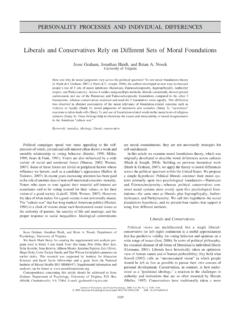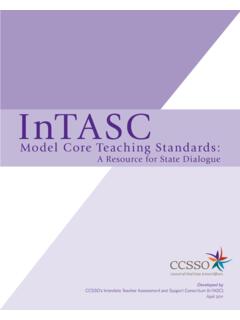Transcription of Framing, Agenda Setting, and Priming: The Evolution of ...
1 Journal of communication ISSN 0021-9916. ORIGINAL ARTICLE. Framing, Agenda Setting, and Priming: The Evolution of Three Media Effects Models Dietram A. Scheufele1 & David Tewksbury2. 1 Department of Life Sciences communication and School of Journalism and Mass communication , University of Wisconsin Madison, Madison, WI 53706. 2 Department of Speech communication and Department of Political Science, University of Illinois at Urbana Champaign, Urbana, IL 61801. This special issue of Journal of communication is devoted to theoretical explanations of news framing, Agenda setting, and priming effects. It examines if and how the three models are related and what potential relationships between them tell theorists and researchers about the effects of mass media.
2 As an introduction to this effort, this essay provides a very brief review of the three effects and their roots in media-effects research. Based on this overview, we highlight a few key dimensions along which one can com- pare, framing, Agenda setting, and priming. We conclude with a description of the con- texts within which the three models operate, and the broader implications that these conceptual distinctions have for the growth of our discipline. In 1997, Republican pollster Frank Luntz sent out a 222-page memo called Language of the 21st century'' to select members of the Congress. Parts of the memo soon spread among staffers, members of Congress, and also journalists.
3 Luntz's message was simple: It's not what you say, it's how you say it'' (Luntz, in press). Drawing on various techniques for real-time message testing and focus grouping, Frank Luntz had researched Republican campaign messages and distilled terms and phrases that resonated with specific interpretive schemas among audiences and therefore helped shift people's attitudes. In other words, the effect of the mes- sages was not a function of content differences but of differences in the modes of presentation. The ideas outlined in the memo were hardly new, of course, and drew on decades of existing research in sociology (Goffman, 1974), economics (Kahneman & Tversky, 1979), psychology (Kahneman & Tversky, 1984), cognitive linguistics (Lakoff, 2004), and communication (Entman, 1991; Iyengar, 1991).
4 But Frank Luntz was the first professional pollster to systematically use the concept of framing as a campaign tool. The Democratic Party soon followed and George Lakoff published Don't Think of an Corresponding author: Dietram A. Scheufele Journal of communication 57 (2007) 9 20 2007 International communication Association 9. Models of Media Effects D. A. Scheufele & D. Tewksbury Elephant (Lakoff, 2004), a short manual for liberals on how to successfully frame their own messages. With the emergence of framing as a communication tool for modern campaigns has come a resurgence of academic research on other cognitive campaign effects, such as Agenda setting and priming, many of which are thought to be related or at least based on similar premises (for overviews, see McCombs, 2004; Price & Tewksbury, 1997; Scheufele, 2000).
5 This special issue of the Journal of communication is an examination of whether and how framing, Agenda setting, and priming are related and what these relationships tell theorists and researchers about the effects of mass media. As an introduction to this issue, this essay will provide a very brief review of the three effects and their roots in media effects research. Next, it will highlight a few key dimensions along which one can compare them. It will conclude with a descrip- tion of the aims of this issue and the broader context within which the relationships between framing, Agenda setting, and priming operate. The emergence of three models of political communication The emerging body of research on framing, Agenda setting, and priming has signaled the latest paradigm shift in political- communication research.
6 Scholars of mass com- munication often suggest that the field passed through a series of paradigms in the 20th century (McQuail, 2005). The early hypodermic needle and magic-bullet mod- els of the 1920s and 1930s were quickly replaced by a paradigm based on the much more theoretically and methodologically sophisticated ideas that Lazarsfeld and his colleagues in Columbia University's Bureau of Applied Social Research put forth in The People's Choice (Lazarsfeld, Berelson, & Gaudet, 1948) and subsequent studies. Media effects were much more complex in nature than previously assumed, they argued, and depended heavily on people's homogenous networks and their selective informational diets, which reinforced existing attitudes rather than changed them.
7 The 1970s marked the second major paradigm shift in research on political communication when Noelle-Neumann's (1973) proclamation about the return of powerful mass media coincided with George Gerbner's (Gerbner & Gross, 1974). development of the theory of cultivation. Ironically, the two researchers had dia- metrically opposed political agendas but came to similar conclusions. Both assumed that mass media had strong, long-term effects on audiences, based on the ubiquitous and consonant stream of messages they presented to audiences. But although Noelle-Neumann often blamed left-leaning journalists for shaping opinion climates and therefore influencing the dynamics of opinion expression and formation, Gerbner identified conservative media conglomerates and especially entertainment television as the main culprit for shaping perceptions of reality by promoting commercially motivated worldviews.
8 Also notable in the 1970s was the birth of Agenda -setting research in political communication . Sparked by the landmark study by McCombs and Shaw (1972), the effect drew considerable attention from re- searchers frustrated by the minimal-effects perspective common at the time. 10 Journal of communication 57 (2007) 9 20 2007 International communication Association D. A. Scheufele & D. Tewksbury Models of Media Effects The 1980s and early 1990s, finally, brought the most recent stage of political- effects research. Sometimes labeled negation models'' (McQuail, 2005), approaches like priming and framing were based on the idea that mass media had potentially strong attitudinal effects, but that these effects also depended heavily on predispo- sitions, schema, and other characteristics of the audience that influenced how they processed messages in the mass media.
9 Parsimony versus precision: framing, Agenda setting, and priming The three models we focus on in this issue framing, Agenda setting, and priming . have received significant scholarly attention since they were introduced. Agenda setting refers to the idea that there is a strong correlation between the emphasis that mass media place on certain issues ( , based on relative place- ment or amount of coverage) and the importance attributed to these issues by mass audiences (McCombs & Shaw, 1972). As defined in the political commu- nication literature, Priming refers to changes in the standards that people use to make political evaluations'' (Iyengar & Kinder, 1987, p. 63). Priming occurs when news content suggests to news audiences that they ought to use specific issues as benchmarks for evaluating the performance of leaders and governments.
10 It is often understood as an extension of Agenda setting. There are two reasons for this: (a) Both effects are based on memory-based models of information process- ing. These models assume that people form attitudes based on the considerations that are most salient ( , most accessible) when they make decisions (Hastie &. Park, 1986). In other words, judgments and attitude formation are directly cor- related with the ease in which instances or associations could be brought to mind'' (Tversky & Kahneman, 1973, p. 208); (b) based on the common theoret- ical foundation, some researchers have argued that priming is a temporal exten- sion of Agenda setting (Iyengar & Kinder, 1987).





